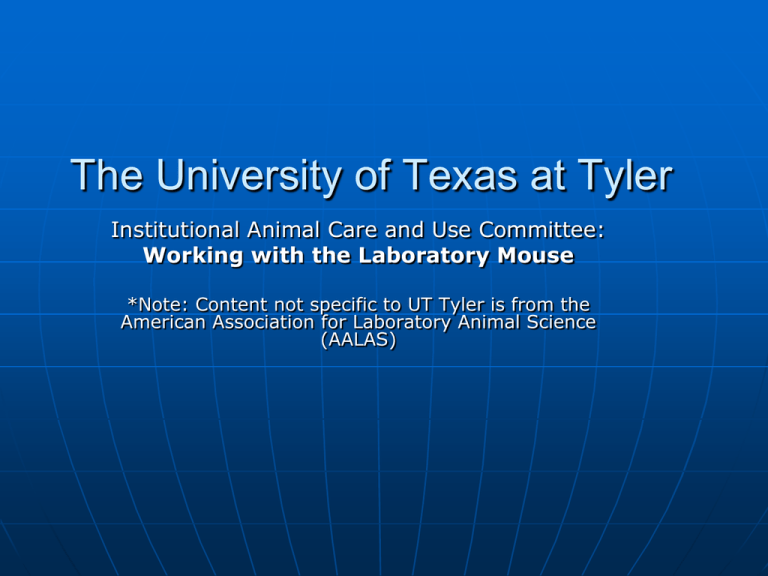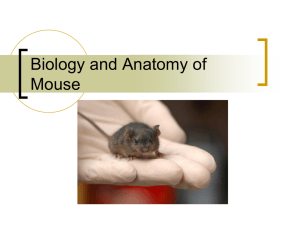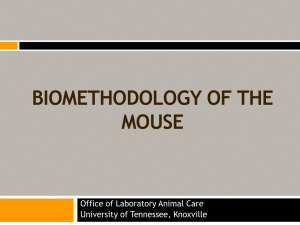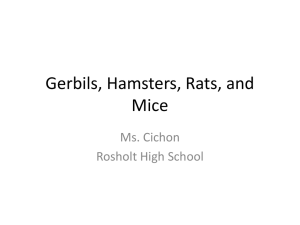
The University of Texas at Tyler
Institutional Animal Care and Use Committee:
Working with the Laboratory Mouse
*Note: Content not specific to UT Tyler is from the
American Association for Laboratory Animal Science
(AALAS)
Working with the Laboratory
Mouse
The goal of this course is to provide information on
the use of mice in research. This course will
address:
Regulatory requirements
Occupational Health and Safety
Housing and Routine Care
Animal Identification
Sex Determination
Clinical Signs of Illness
Humane Endpoints
Euthanasia
Regulatory Requirements
To ensure the humane treatment of laboratory
animals, animal research is regulated by two
federal agencies:
• The United States Department of Agriculture (USDA) /
Animal Care enforcing the Animal Welfare Act
Regulations
• The National Institutes of Health / Office of Laboratory
Animal Welfare (OLAW) enforcing the PHS Policy
The Animal Welfare Act Regulations and the PHS
Policy mandates differ greatly with respect to the
laboratory strains of mice and rats. These species
are not covered by the USDA but are included in
PHS regulations and policy.
Regulatory Requirements
The UT Tyler IACUC has policies and
procedures on the use of animals that reflect
federal and other government mandates and
professional standards in the laboratory animal
field—refer to the UT Tyler IACUC Policy
Handbook available at:
http://www.uttyler.edu/research/animals.htm
Occupational Health & Safety
Public Health Service Policy
•
•
The Public Health Service Policy requires
institutions to have an occupational
health and safety program for
individuals working with laboratory
animals. This requirement is also
reiterated in the Guide.
It is the responsibility of principal
investigators to ensure that their
laboratory staff are informed of and
participate in UT Tyler’s occupational
health and safety program.
Occupational Health and Safety:
Hazards of Working with Mice
Working with mice is associated with
the following hazards which will be
described more fully in the following
pages:
• Injuries
• Allergies
• Zoonoses
Occupational Health & Safety
Injuries and Allergies
Injuries
•
Personnel handling a mouse can be bitten if the animal is
poorly restrained. Though mice are often inclined to bite
when frightened, their incisors do not always break the
skin.
•
Poor technique in handling and restraining a mouse may
also cause injury to the mouse.
•
Training staff to work effectively and humanely with mice is
essential to prevent injuries to people and mice.
Allergies
•
People can develop an allergy to rodents after having
contact with them for some time.
•
Persons who develop allergy symptoms should seek
medical counseling and may have to discontinue working
with this species.
Housing and Routine Care:
Animal Crowding
Animal crowding in a cage affects environmental
quality (the accumulation of urine, for example,
leads to excess ammonia and moisture).
Crowding can also cause newborn pups to be
injured or killed. Crowding is a special concern for
multiple litters in a cage since pups grow very
quickly and rapidly increase their output of
excreta.
In particular, if the mother is about to give birth to
a second litter, the first litter should be weaned
and removed to new cages to prevent smothering
and trauma of the newborns.
Routine Sanitation
Routine sanitation and environmental controls are necessary
for protecting animal health and for minimizing the
introduction for non-experimental variables which could
undermine the quality of research data.
Sanitation schedules vary according to the type of mouse
caging.
Based on the types of caging and bedding in use at your
facility, your institution will have a standard operating
procedure (SOP) on the sanitation schedule for mouse
cages.
Environmental Controls
The Guide for the Care and Use of Laboratory Animals establishes
standards for laboratory animal environments in regard to:
•
•
•
•
•
•
•
•
room temperature
humidity
ventilation
illumination and light schedule
noise abatement
The details of these standards are generally not a concern to
researchers who house their animals in an institutional animal
facility, because it is the animal care staff who have the
responsibility of operating the facility in compliance with these
environmental standards.
For practical considerations due to common work hours,
researchers should be aware of the lighting schedules used in the
rodent housing rooms (commonly 12 hr light:12 hr dark or 14 hr
light:10 hr dark).
If researchers working late turn on the lights in the animal rooms
during the dark period, the disruption of the light schedule may
cause the animals to be perturbed, which may have effects on
breeding performance and on circadian rhythms.
Animal Handling and Restraint
It's important to remember the following:
• As a small animal, mice can be easily injured if
handled roughly. You should learn how to
handle them firmly but gently and with
confidence to avoid injuring these delicate
animals.
• Mice are inclined to become aggressive and
bite. Although their teeth seldom break
through your skin, a bite can hurt! Develop
your confidence in handling mice by learning
from an experienced mentor and practice hand
restraint first on anesthetized mice.
Animal Handling and Restraint
If a mouse does bite you, train yourself not to
fling the animal from your hand as a fall can hurt
the animal and cause the loss of an animal and
possible future genetic contamination of strains
and stocks.
Instead, remember that the mouse has bitten
you in fear and self-defense. At that moment,
you and the mouse share a mutual desire to
disengage from each other.
The best way to remove a mouse that is hanging
on to your finger is to train yourself to lower your
hand back into its cage. Presented with a retreat
to its home cage, the mouse will quickly jump off
your finger.
Animal Handling and Restraint
The succeeding screens will show:
•
•
Common approaches for hand restraint of
mice.
Two devices commonly used to restrain
mice.
Hand Restraint
There are two common hand methods for
restraining mice. No matter how you will restrain
the mouse, mice are picked up the following way:
• If your mice are in barrier or containment housing,
please open their cages in an appropriate hood or
laminar-flow workbench.
• Remove the cage top if they are housed in a filter-top
cage.
• Place the wirelid top sideways on top of the cage.
• Pick up a mouse by the tail (away from the tail tip) and
lift the mouse directly to the wirelid. You will find that
the wirelid is a useful area to which the mouse will want
to hang on with its front feet, allowing you the
opportunity to reposition your grasp.
Tail Wrap Method
In the tail wrap method, you transfer the tail
from your thumb and forefinger to the 4th and
5th fingers of the same hand. These fingers press
into your palm the mouse's tail, close to the
animal's rump. Then, your thumb and forefinger
grasp a scruff of skin at the occiput of the mouse.
In this method, the mouse is held by two points:
the occiput and the base of the tail. To further
immobilize the hindquarters, you may gently
entrap one leg along with the tail beneath your
5th finger. It is important to provide back support
to the mouse and avoid hyperextension of its
back.
Points to remember:
When picking up a mouse –
•
•
•
•
Pick up the tail at the middle, not the tip. A mouse does not
need to be picked up at the base of the tail like a rat does,
because the mouse is light and its weight will not damage
its tail.
Never dangle a mouse by its tail, but instead lift it directly
to the cage wirelid or some other support. When dangled,
mice appear anxious as seen by the their behavior in
hyperextending their feet.
Mice feel more secure when given a protective cover, e.g.,
by an overturned cup-like device. This is a means to hold a
mouse securely and comfortably for a few moments.
If you need a place to briefly sort and hold your mice, say
while you are rapidly administering injections to a cage of
mice, each mouse can be placed on the wirelid after its
injection. Mice will stay on their wirelid a short while if food
blocks are present, due to their instincts for food. If you
quickly make all your injections, all the mice can be treated
without a mixup of repeated or skipped administrations.
Determining Sex and Age
Refer to the image below: the top two mice are neonates and note that
the anogenital distance is larger in the male than in the female neonates,
the penis and vulva cannot be easily differentiated and so are referred to
as a genital papilla. The bottom two animals are adults; genitalia are
differentiated.
Determining Sex and Age
•
•
•
Also, nipples become evident in females at about 10 days
of age.
Male mice, like other rodent species, retain an open
inguinal canal in adulthood. That is, the descended testicles
communicate with the abdominal cavity. Depending on the
position in which the mouse is held, the testicles may be
retracted into the abdomen or descended into the scrotum.
Because of the open inguinal canal, castration of mice
requires that the surgeon use caution when applying
tension to the testicle. Too much tension can result in the
intestines being pulled through the inguinal canal.
Determining Sex and Age
•
•
•
Occasionally people experience difficulty in determining
gender in mice at weaning age, although the anogenital
distances are markedly different between males and
females.
Newborns have a subtle difference in the anogenital
distance, due to their small size and scale of the anatomical
landmarks. In determining the gender of newborns, it’s
best to examine several animals side by side to distinguish
the males from the females.
The difference becomes more apparent after a few days of
age. Another landmark is the presence of nipples in the
females from 10 days of age, which are absent in the male.
Darker mice are more difficult to differentiate than light
colored mice.
Sex and Age
Sex and Age
Newborn through Day 5
The images on the next slide show pups
from 1 to 5 days of age. (The following
slides show mouse pups from 6 to 15 days
of age.)
Newborn, or 1 day old, mice are very red,
helpless, and hairless. Because of their
color and lack of hair, they are often
referred to as pinkies.
Sex and Age
Sex and Age
Day 6 through 10
The next slide shows images of pups
at ages of 6 through 10 days. The
stages of fur growth are an
important indicator of age during this
period of time
Sex and Age
Here are images of
pups at ages of 6
through 10 days. The
stages of fur growth
are an important
indicator of age during
this period of time.
Sex and Age
Day 11 through 28
The next slide shows images of pups
from 11 days through 4 weeks of
age.
This 18 day period is one of rapid
growth and change as their eyes
open and activity increases.
Sex and Age
Reproductive Data Of Mice
Stage
•
Sexual maturity
•
Estrous cycle
•
Gestation
•
Weaning age
•
Reproductive life
•
Life span
•
Pups begin eating
dry food
Age
•
40-60 days
•
4 – 5 days
•
21 days
•
21-30 days
•
±8 months
•
1 - 3 years
•
12 – 14 days
Minimizing Pain and Distress
WHEREVER POSSIBLE, PAIN/DISTRESS SHOULD BE
ELIMINATED!
Clinical Signs of Illness
•
Achieving humaneness in animal research depends upon the
control and, whenever possible, the reduction of animal pain and
distress.
•
Minimizing pain and distress also reduces the impact of these
extraneous factors on the research, i.e., as sources of nonexperimental variation.
For example, in a mouse model of experimental autoimmune
encephalomyelitis, implementation of supportive treatment
(hydration and nutrition) was shown to protect against loss of body
weight and to greatly extend survival of the animals in the study,
from 25 to 60 days. (Ref.: Lab Animal, 29(5): 40-46, 2000.)
Minimizing Pain and Distress
Causes of Pain and Distress in Mice
•
•
•
Research staff should be familiar with the causes
of animal pain and distress. Pain and distress are
caused by spontaneous and experimentallyinduced disease or injury.
Many factors may contribute to an animal’s
distress or discomfort, including extreme
homeostatic challenges.
Pain/distress should be minimized to an extent
that is possible and compatible with experimental
objectives.
Factors in Pain & Distress
Changes in the following parameters may cause or be associated with animal
pain or distress:
temperature (environmental and body temperature)
hypoxia
edema
blood electrolytes, e.g. hyperkalemia
dehydration
environment
• caging
• cage mates
• lighting
• humidity
• noise
• Vibration
Note - Smaller mammals experience physiologic changes such as starvation
(due to high metabolic rate) and chilling (due to large ratio of body surface
area to mass) faster than larger animals.
Signs of Pain and Distress
•
Signs of pain and distress in rodents are not easy to
detect because of their body size, their tendency to
conceal outward signs of pain and distress, and their
habit of hiding or freezing when disturbed.
•
Nevertheless, signs of pain or distress can be detected
in rodents by carefully observing subtle changes in
behavior.
•
The ability to properly assess pain and distress in
rodents requires:
--knowledge of normal rodent behavior and
appearance
--a systematic approach to observing clinical signs in
rodents
Assessing Appearance and Behavior
From the Cage Exterior
•
Routinely inspect the rodents through the top and sides
of the cage. Get in the habit of removing the cage from
the shelf and looking through all sides of the cage. Signs
of distress may be missed in animals on lower or upper
shelves because of low lighting or difficult access.
•
Baby mice and rats can be inconspicuous within piles of
bedding or nestboxes.
Cage Wirelid Off
•
Lift the cage wirelid to elicit a response to your presence.
This disturbance may prompt the animals to move about
the cage. Examine the animals’ behavior, gait, and hair
coat.
•
Normal mice are inquisitive and explore their cage
perimeter.
Behaviors to Observe
•
•
•
•
•
•
Abnormal mice may huddle in their cage, or they may fail to move
around and explore their cage. In addition, mice may vocalize when
approached.
Inspect the animal’s mode and speed of movement. Observe the tail
position when the animal moves.
Is the gait (how it walks) awkward? Observe how all limbs move
while walking.
Does the animal teeter or stumble?
Is the animal’s back hunched and abdomen tucked while walking?
Is the tail held stiff and upright? Or does the tail drag?
Tip: Observe a cage of normal animals for a comparison.
•
Examine (and treat) an individual mouse by gently restraining the
animal. You can move the animal to a separate examination box for
detailed clinical inspection.
Red Tears
Stressed mice and rats commonly display red tears or
porphyrin staining. Porphyrin is an oily discharge from
the Harderian glands located in the orbit behind the
eyes.
Porphyrin staining may be seen:
•
on the nose,
•
around the eyelids,
•
or on the medial aspect of the forepaws that become
stained through grooming of the face.
Affected rodents may also fail to groom or they may have
piloerection of the hair coat (giving a spiky appearance
to the hair).
Types of Observations
A common approach to assessing animal appearance and behavior is
through observation of the following:
Activity Level
• e.g., hypoactivity (hunched, huddled, lethargic), hyperactivity,
restlessness, lack of inquisitiveness
Attitude
• e.g., arousal, depression, awareness of surroundings
Behavior, Spontaneous
• e.g., vocalization, self-trauma, isolation from cage mates. These
observations are made without disturbing the animal.
Behavior, Provoked
• e.g., vocalization, hiding, aggressiveness, minimal response.
These observations are made when the animal is disturbed or
even prodded.
Types of Observations
Body Condition
• e.g., emaciation, missing anatomy
Food and Fluid Intake
• e.g., elimination of feces and urine
Fur and Skin
• e.g., unkempt or greasy or dull fur; porphyrin staining around
eyes and nostrils; cyanotic, pale, or congested mucous
membranes or skin (ears, feet, tail); skin lesions; soiled
anogenital area
Eyes
• e.g., clarity/condition of lens, cornea; position of globe (e.g.,
sunken in orbit or protruding); condition of eyelids, encrustation
Posture
• e.g., hunched back, tucked abdomen; prostrate; head tucked
down
Types of Observations
Locomotion
• e.g., gait, ataxia, lameness, action of each limb, position of tail
when ambulating
Neurological
• e.g., tremor, convulsion, circling, paralysis, head tilt, coma
Vital Signs
• e.g., respiratory distress (open mouth breathing, pronounced
chest movement)
Other clinical parameters that are relevant to your study
• e.g., presence and status of tumors, infection, or surgical
wounds
Tip: It is helpful to have blank forms to use as "score sheets"
to enter and track each parameter assessed.
Physical Examination
•
After assessing the animals’ appearance and behavior, conduct a
physical exam using methods that are appropriate to the species
and experimental model.
•
Performing a clinical exam on rodents is somewhat limited
compared to larger animals due to the greater difficulty in venous
access and the smaller sampling size of biological fluids.
Nevertheless, specific methods and equipment for rodents allow a
clinical exam to provide information on animal well being.
•
Use quantifiable characteristics whenever possible. These can be
tracked over time and compared to a starting baseline or to normal,
untreated animals.
•
Such measurements are not only helpful for clinical assessments,
but they can also be useful when compiling research data and
writing manuscripts. Later in this course, simple record-keeping
methods will be discussed to help utilize this information.
Physical Examination
You may evaluate:
•
Behavior
•
Body weight
•
Surface lesions (wounds, masses)
•
Hydration status
•
Body temperature (telemetric methods)
•
Blood parameters (Blood collection can be difficult/stressful
in mice; may be used to confirm disease or failed
treatment.)
•
For specific recommendations on evaluating these
parameters and supportive procedures, refer to the AALAS
Learning Library course Post-Procedure Care of Mice and
Rats in Research: Minimizing Pain and Distress.
Humane Endpoints
Defining Procedure
•
•
•
All of the federal laws, regulations, policies and
guidelines applicable to animal research have a
core requirement for the humane treatment of
the animals involved in a study.
Accordingly, your IACUC will have requirements
for the proper care (peri-procedural care) of your
animals prior to, during, and after a research
procedure.
What is a procedure? A procedure is any activity
carried out on the animal, such as a behavioral
observation, a venipuncture, or a surgery.
Humane Endpoints
Defining Procedure (cont)
•
•
•
•
This peri-procedural care requirement
covers:
properly preparing the animal to
humanely undergo the procedure,
supporting the animal’s physiological
function during the procedure, and
providing additional supportive care to aid
the animal in recovering from the
procedure.
Humane Endpoints
Responsibility for Care
•
•
•
The investigator has the responsibility to see that staff
working with the animals are properly trained to not only
perform the procedure humanely but also to provide the
necessary supportive care to the animals.
When performing any procedure, such as a blood collection,
you should think through the steps that are necessary to
protect the animal’s welfare.
For example, for blood collection, you should limit the
volume taken acutely or chronically. And, with any
venipuncture, you should be prepared to care for the
animal in the event of trauma to the vein area or excess
hemorrhage. Refer to your institution’s IACUC and
attending veterinarian for specific guidelines.
Acclimation
•
•
•
•
•
Upon arrival to your facility, your mice should have an
acclimation period before they are used in research
studies.
This period of time allows animals to adapt to a new
environment.
Effects of transportation stress include alterations in various
blood parameters, immune cell function, food intake, and
animal behavior.
The period of time necessary for biological stabilization will
depend on the parameters to be studied.
Refer to your institution's attending veterinarian for
recommendations that are appropriate for your project.
Typically, acclimation periods can range from days to over
a week, depending on the studies involved.



![Historical_politcal_background_(intro)[1]](http://s2.studylib.net/store/data/005222460_1-479b8dcb7799e13bea2e28f4fa4bf82a-300x300.png)



